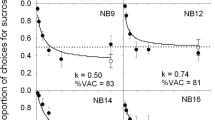Abstract
Do rats run and respond at a higher rate to run during the dark phase when they are typically more active? to answer this question, Long Evans rats were exposed to a response-initiated variable interval 30-s schedule of wheel-running reinforcement during light and dark cycles. Wheel-running and local lever-pressing rates increased modestly during the dark phase. a second experiment examined the potential role of food-anticipatory activity in this effect by delaying postexperimental session feeding by 6 hr No increase in wheel-running and lever-pressing rates was observed during the dark phase. This suggests that the effect of light/dark cycle on running and responding for the opportunity to run depended upon food-anticipatory activity.
Similar content being viewed by others
References
ASCHOFF, J., VON GOETZ, C., & HONMA, K. (1983). Restricted feeding in rats: Effects of varying feeding cycles. Zeitschrift fuer Tierpsychologie, 63, 91–111.
BAUER, M.S. (1990). Intensity and precision of circadian wheel running in three outbred rat strains. Physiology & Behavior, 47, 397–401.
BAUMAN, R.A. (1992). The effects of wheel running, a light/dark cycle, and the instrumental cost of food on the intake of food in a closed economy. Physiology & Behavior, 52, 1077–1083.
BAUMAN, R.A., & KANT, G.J. (1995). Time cost of alternation reduced demand for food in a closed economy. Physiology & Behavior, 57, 1187–1193.
BELKE, T.W. (1996). The effect of a change in body weight on running and responding reinforced by the opportunity to run. Psychological Record, 46, 421–433.
BELKE, T.W. (1997). Running and responding reinforced by the opportunity to run: Effect of reinforcement duration. Journal of the Experimental Analysis of Behavior, 67, 337–351.
BELKE, T.W. (2000). Differences in responding for sucrose and wheel-running reinforcement: Excitatory stimulus effects or inhibitory after-effects? Animal Learning & Behavior, 28, 332–343.
BELKE, T.W. & HEYMAN, G.M. (1994). A matching law analysis of the reinforcing efficacy of wheel running in rats. Animal Learning & Behavior, 22, 267–274.
COLEMAN, G.J., HARPER, S., CLARKE, J.D. & ARMSTRONG, S. (1982). Evidence for a separate meal-associated oscillator in the rat. Physiology & Behavior, 29, 107–115.
COLLIER, G., & HIRSCH, E. (1971). Reinforcing properties of spontaneous activity in the rat. Journal of Comparative Physiological Psychology, 77, 155–160.
DAWSON, K.A., CROWNE, D.P., RICHARDSON, C.M., & ANDERSON, E. (1987). Effects of age on nocturnal activity rhythms in rats. Progress in Clinical and Biological Research, 227B, 107–110.
EDMONDS, S.C., & ADLER, N.T. (1977). Food and light as entrainers of the circadian running activity in the rat. Physiology & Behavior, 18, 915–919.
EIKELBOOM, R., & LATTANZIO, S.B. (2003). Wheel access duration in rats: II. Day-night and within-session changes. Behavioural Neuroscience, 117, 825–832.
EIKELBOOM, R., & MILLS, R. (1988). A microanalysis of wheel running in male and female rats. Physiology & Behavior, 43, 625–630.
FISONE, G., BORGKVIST, A., & USIELLO, A. (2004). Caffeine as a psychomotor stimulant: mechanism of action. Cellular and Molecular Life Sciences, 61, 857–872.
HONMA, K.I., VON GOETZ, C., & ASCHOFF, J. (1983). Effects of restricted daily feeding on free running circadian rhythms in rats. Physiology & Behavior, 30, 905–913.
IVERSEN, I.H. (1993). Techniques for establishing schedules with wheel running as reinforcement in rats. Journal of the Experimental Analysis of Behavior, 60, 219–238.
IVERSEN, I.H. (1998). Simple and conditional visual discrimination with wheel running as reinforcement in rats. Journal of the Experimental Analysis of Behavior, 70, 103–121.
KAGAN, J. & BERKUN, M. (1954). The reward value of running activity. Journal of Comparative and Physiological Psychology, 47, 108.
MISTLBERGER, R.E. (1994). Circadian food-anticipatory activity: formal models and physiological mechanisms. Neuroscience and Behavioral Reviews, 18, 171–195.
MUELLER, D.T., HERMAN, G., & EIKELBOOM, R. (1999). Effects of short- and long-term wheel deprivation on running. Physiology & Behavior, 66, 101–107.
PENG, Mt., JIANG, M.J., & HSU, H.K. (1980). Changes in running-wheel activity, eating and drinking and their day/night distributions throughout the lifespan of the rat. Journal of Gerontology, 35, 339–347.
PENG, M.T., & KANG, M. (1984). Circadian rhythms and patterns of running-wheel activity, feeding and drinking behaviours of old male rats. Physiology and Behavior, 33, 615–620.
STEPHAN, F.K. (1981). Limits of entrainment to periodic feeding in rats with suprachiasmatic lesions. Journal of Comparative Physiology, 143, 401–410.
STEPHAN, F.K. (1992). Resetting of a feeding-entrainable circadian clock in the rat. Physiology and Behavior, 52, 985–995.
STEWART, K.T., ROSENWASSER, A.M., & ADLER, N.T. (1985). Interactions between nocturnal feeding and wheel running patterns in the rat. Physiology & Behavior, 34, 601–608.
Author information
Authors and Affiliations
Corresponding author
Additional information
The first experiment in this report is based on an undergraduate thesis submitted by the second author in partial fulfillment of a B.A. degree at Mount Allison University, Sackville, Canada. This research was supported by Grant 0GP0170022 from the Natural Sciences and Engineering Research Council of Canada to the second author.
Rights and permissions
About this article
Cite this article
Belke, T.W., Mandrona, A.R., Conrad, K.M. et al. Effect of Light/Dark Cycle on Wheel Running and Responding Reinforced by the Opportunity to Run Depends on Postsession Feeding Time. Psychol Rec 58, 391–404 (2008). https://doi.org/10.1007/BF03395625
Published:
Issue Date:
DOI: https://doi.org/10.1007/BF03395625




